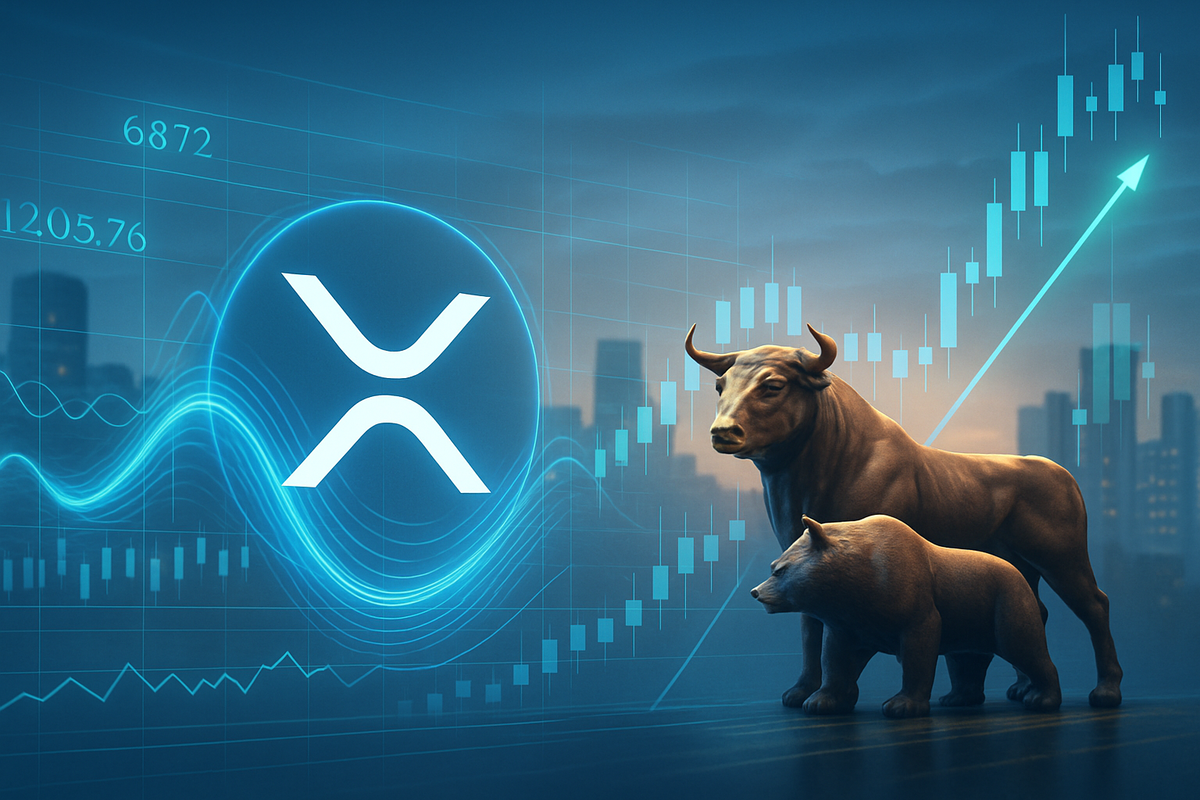
The financial world is witnessing a pivotal moment as U.S. spot XRP Exchange-Traded Funds (ETFs) begin to hit the market, signaling a profound shift in how digital assets are integrated into traditional finance. While the concept of a "first" U.S. spot XRP ETF has been a topic of fervent speculation, the reality as of October 4, 2025, is that several XRP-linked investment products have already launched, with more significant spot ETF approvals from major financial institutions anticipated in the immediate future. This groundbreaking development, underpinned by recent regulatory clarity and a favorable legal landscape, is poised to unlock substantial institutional capital and reshape the investment landscape for digital assets.
These new ETF offerings are not merely new investment vehicles; they represent a powerful legitimizing force for XRP and the broader cryptocurrency market. By providing regulated, accessible, and familiar avenues for traditional investors to gain exposure to XRP, these products are bridging the gap between the nascent digital asset economy and established financial markets. The implications are far-reaching, promising enhanced liquidity, increased market stability, and a potential re-evaluation of digital assets as mainstream, investable commodities.
The Floodgates Open: A Detailed Look at XRP ETF Launches and Their Precursors
The journey to U.S. spot XRP ETFs has been paved by a series of critical regulatory and legal developments, culminating in the current wave of product launches. The most significant catalyst was the resolution of the protracted legal battle between Ripple Labs (NASDAQ: XRP) and the U.S. Securities and Exchange Commission (SEC) in August 2025. This landmark decision provided crucial regulatory clarity, distinguishing between institutional sales of XRP (deemed unregistered securities) and secondary market sales on exchanges, which were not. Following this, Ripple paid a civil penalty, a figure substantially lower than initial SEC demands, effectively removing a major overhang for XRP.
Further bolstering the environment for crypto ETFs, the SEC approved Generic Listing Standards for Commodity-Based Trust shares in September 2025. These new standards have streamlined the listing process for various crypto-related ETFs by removing the previous requirement for 19b-4 filings and their associated lengthy review periods, thereby accelerating timelines for a range of altcoin ETFs, including XRP. As a direct result of this newfound clarity and efficiency, Bloomberg ETF analysts now estimate a near 100% probability for the approval of spot XRP ETFs, with the SEC reportedly withdrawing previous delay notices for such products.
Indeed, the market has already seen the initial wave of XRP-linked products. The REX-Osprey XRP ETF (XRPR), considered the first U.S.-listed fund offering direct spot exposure to XRP under the Investment Company Act of 1940, debuted on the Cboe exchange on September 18, 2025. It recorded a remarkable $37.7 million in first-day trading volume, marking the largest ETF launch of 2025. Simultaneously, a leveraged futures-based XRP ETF, Teucrium 2x Long Daily XRP ETF (XXRP), went live automatically on October 4, 2025, offering 2x daily exposure, and another spot-linked ETF, XRPI, has also begun trading, albeit structured more conservatively around futures contracts. While a temporary U.S. government shutdown is currently impacting the SEC's routine operations and may briefly delay the final sign-off on S-1 registration statements for some pending spot ETFs, the momentum is undeniable. Major financial institutions, including Grayscale, 21Shares, Bitwise, Canary Capital, CoinShares, and WisdomTree, are awaiting SEC rulings on their spot XRP ETF applications between October 18 and October 25, 2025, with Franklin Templeton's application expected by November 14. This flurry of activity has already driven XRP's price above $3.00, fueled by speculation and significant "whale" accumulation, signaling strong market confidence.
Winners and Losers: Corporate Impact in a Shifting Landscape
The advent of U.S. spot XRP ETFs is poised to create significant winners and losers across the financial ecosystem, fundamentally altering revenue streams and competitive landscapes.
Ripple Labs (NASDAQ: XRP) stands as a primary beneficiary. With its native token, XRP, now gaining widespread institutional accessibility through regulated investment products, the company's ecosystem and adoption could see exponential growth. The increased demand driven by ETFs is likely to bolster XRP's price, enhancing Ripple's balance sheet and providing further capital for its global payments network and other ventures. The company's hard-won legal clarity with the SEC has been instrumental in this development, positioning it uniquely in the digital asset space.
Traditional asset managers and financial institutions that successfully launch and manage these ETFs are also clear winners. Firms like Grayscale, 21Shares, Bitwise, Canary Capital, CoinShares, WisdomTree, and Franklin Templeton, which have applications pending, stand to capture substantial assets under management (AUM) and generate significant fee revenue. Their ability to attract institutional capital, including pension funds and 401(k) accounts, will be a key differentiator. Conversely, those traditional firms that fail to adapt or are slow to enter the crypto ETF market risk falling behind, potentially losing clients to more agile competitors.
Cryptocurrency exchanges such as Coinbase (NASDAQ: COIN) will likely experience a mixed impact. While increased liquidity and legitimacy for XRP could boost trading volumes on their platforms, the existence of ETFs might also divert some retail and institutional investors away from direct crypto purchases on exchanges, opting instead for the regulated and familiar ETF wrapper. However, many exchanges could also benefit by serving as custodians for these ETFs, creating new revenue streams through secure asset storage. Brokerage firms and wealth management platforms, like Charles Schwab (NYSE: SCHW) and Fidelity (NYSE: FII), that offer these ETFs to their clients will see increased product offerings and potentially higher client engagement, solidifying their position as comprehensive financial service providers.
A Wider Lens: Broader Implications and Historical Parallels
The approval and launch of U.S. spot XRP ETFs represent more than just a new investment product; they signify a maturing regulatory environment and a broader acceptance of digital assets within traditional finance. This event fits squarely into the overarching trend of institutional adoption of cryptocurrencies, a movement that gained significant traction with the approvals of Bitcoin (BTC) and Ethereum (ETH) futures and spot ETFs. The key difference here is the explicit regulatory clarity provided to XRP following the SEC vs. Ripple lawsuit, which has arguably de-risked the asset in a way that few other altcoins currently enjoy.
The ripple effects of XRP ETFs are expected to extend across the entire digital asset landscape. This development could "open the floodgates" for other altcoin ETFs, with analysts already speculating on the imminent approval of spot ETFs for assets like Solana (SOL), Litecoin (LTC), and Dogecoin (DOGE). This could intensify competition among digital assets for institutional capital and potentially trigger "capital rotation," where investments might shift from established cryptocurrencies like Bitcoin and Ethereum into these newer, more accessible altcoin ETF offerings. The streamlined Generic Listing Standards are crucial here, making future altcoin ETF approvals a more predictable and faster process.
Regulatory bodies, particularly the SEC, are navigating a complex and evolving landscape. The approval of XRP ETFs, especially after the contentious lawsuit, demonstrates a pragmatic shift towards integrating digital assets under existing securities frameworks where appropriate. This could set a precedent for how other digital assets are classified and regulated, potentially leading to a more harmonized and clearer regulatory framework for the entire crypto industry in the U.S. Historically, the introduction of commodity ETFs (like gold) and later equity sector ETFs revolutionized how investors accessed specific markets; crypto ETFs are doing the same for the digital asset space, making it accessible to a much wider, often risk-averse, investor base.
What Comes Next: Navigating the Future of Digital Asset Investment
The immediate future for XRP ETFs is poised for further expansion and integration. In the short term, the market anticipates the imminent approval and launch of additional spot XRP ETFs from major financial players, potentially leading to a simultaneous launch of all pending crypto spot ETFs once the U.S. government shutdown concludes and SEC operations normalize. This synchronized release could create a significant surge in market activity and institutional inflows. Investors should closely monitor the SEC's announcements regarding these applications, particularly those from Grayscale, 21Shares, and Bitwise, expected in mid-October.
Longer term, the implications are profound. The sustained influx of institutional capital, with initial estimates ranging from $4 billion to $8 billion in the first year alone, and some analysts projecting figures as high as $10 billion to $20 billion, will profoundly impact XRP's market dynamics. This capital, including investments from pension funds and 401(k) accounts, is expected to create a more stable and long-term demand base for XRP, potentially dampening extreme volatility over time. This increased institutional adoption could further solidify XRP's position as a legitimate and widely recognized digital asset, transitioning it from a niche altcoin to a core component of diversified investment portfolios.
Strategic pivots will be required across the financial industry. Traditional brokers and wealth advisors will need to educate themselves and their clients on these new products, integrating them into existing financial planning strategies. Crypto-native firms may need to adapt their business models to compete with or collaborate with traditional finance giants. Market opportunities will emerge in areas like ETF liquidity provision, sophisticated trading strategies, and new research and analysis focused on crypto ETFs. Challenges will include managing potential market saturation, ensuring robust cybersecurity for underlying assets, and navigating any future regulatory shifts. Potential scenarios range from a steady, sustained growth in XRP's valuation driven by consistent ETF inflows to more volatile periods of profit-taking and market corrections, similar to those observed after Bitcoin and Ethereum ETF launches.
A New Dawn for Digital Assets: Concluding Thoughts
The launch of U.S. spot XRP ETFs marks a watershed moment, fundamentally altering the landscape for digital asset integration into traditional finance. The resolution of the SEC vs. Ripple lawsuit, coupled with the SEC's new Generic Listing Standards, has provided an unprecedented level of regulatory clarity, paving the way for these innovative investment products. We are now witnessing the tangible results, with several XRP-linked ETFs already trading and more from major financial institutions on the cusp of approval.
This development is set to unlock substantial institutional capital, significantly boosting XRP's market legitimacy, liquidity, and potentially its price. While short-term volatility due to "sell the news" events or profit-taking cannot be ruled out, the long-term outlook points towards a more stable, mature, and widely adopted XRP market. The broader significance lies in the precedent it sets for other altcoins and the continued mainstreaming of the digital asset class.
Investors should watch closely for further SEC approvals in the coming weeks and months, particularly how these new ETFs perform in terms of trading volume and AUM. The evolution of regulatory frameworks, the entry of more institutional players, and the overall market reaction will be crucial indicators of the lasting impact of XRP ETFs. This is not merely an incremental change; it is a transformative event that solidifies digital assets as an undeniable force in the global financial system, requiring investors and financial professionals alike to adapt to this new era.
This content is intended for informational purposes only and is not financial advice.





